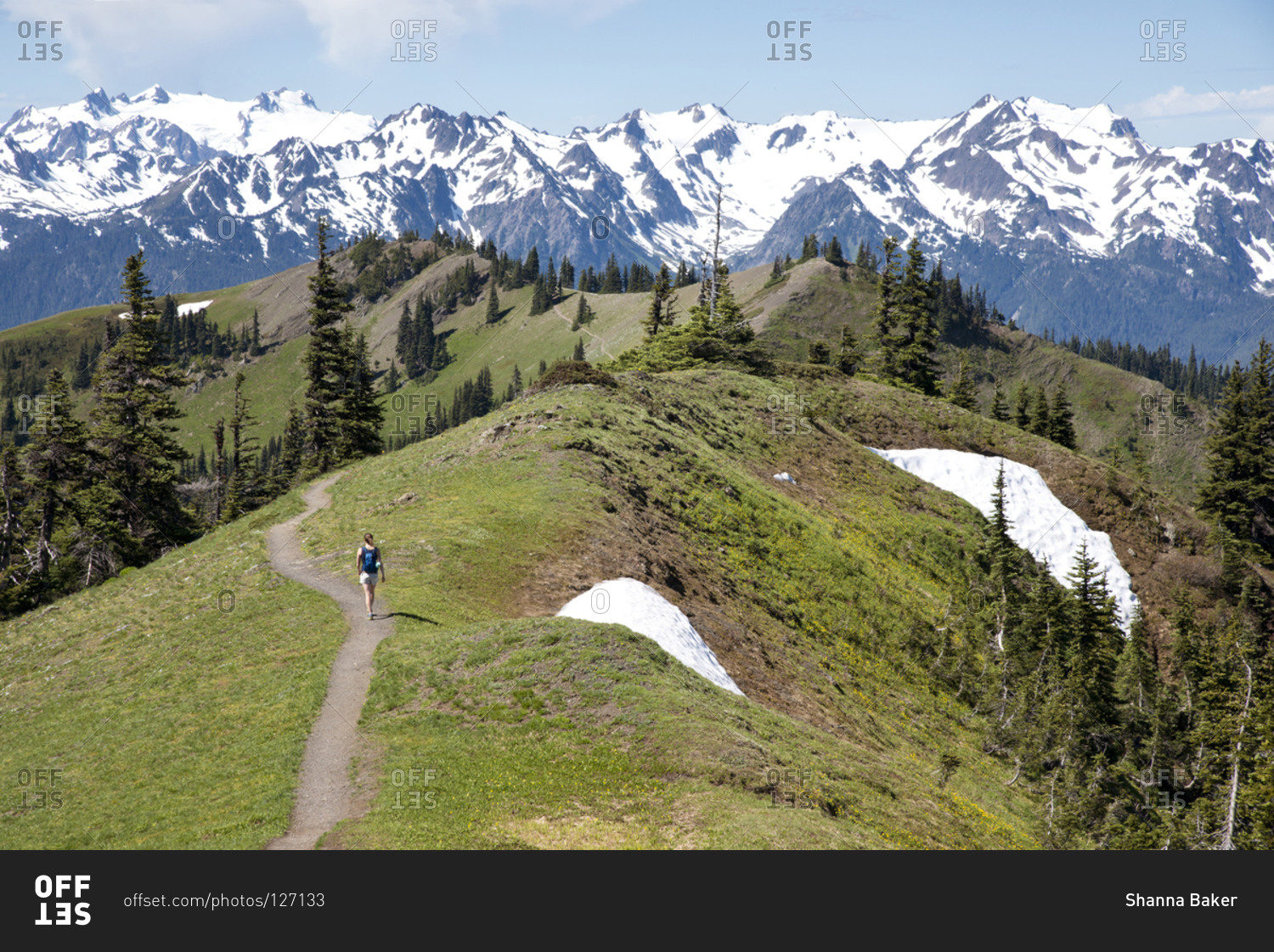Hurricane Ridge hiking offers breathtaking views and diverse trails for all experience levels. From challenging climbs with rewarding panoramic vistas to gentler strolls through alpine meadows, this iconic location in Olympic National Park caters to every adventurer. This guide will equip you with the knowledge and planning tools necessary for a safe and unforgettable experience, covering everything from trail descriptions and seasonal considerations to safety precautions and photographic opportunities.
We’ll delve into the specifics of various trails, detailing their difficulty, length, and the stunning scenery you can expect. Learn about the best time to visit, considering weather patterns and accessibility throughout the year. We’ll also cover essential safety tips, wildlife encounters, and how to best capture the beauty of Hurricane Ridge through photography. Get ready to explore one of the Pacific Northwest’s most spectacular hiking destinations!
Trail Description and Difficulty
Hurricane Ridge in Olympic National Park offers a variety of hiking trails, catering to different experience levels and preferences. The trails range from easy, paved walks perfect for families to more challenging hikes with significant elevation gain, rewarding hikers with stunning panoramic views. Understanding the terrain, trail lengths, and difficulty levels is crucial for planning a safe and enjoyable experience.
Trail Terrain and Elevation Changes
The terrain on Hurricane Ridge trails varies considerably. Some trails are relatively flat and well-maintained, consisting primarily of packed dirt and gravel. Others involve steeper inclines and declines, sometimes traversing rocky sections or traversing uneven, root-filled paths. Elevation changes are significant on some trails, with substantial climbs and descents adding to the challenge. For example, the Hurricane Hill Trail, a popular choice, involves a considerable elevation gain over a relatively short distance, while the easier trails near the visitor center remain mostly level.
Surface conditions can also vary depending on the season; snow and ice can be present during the winter months, impacting trail conditions and accessibility.
Trail Lengths and Hiking Times
The length and estimated hiking time for Hurricane Ridge trails vary greatly. Shorter, easier trails, like the paved paths near the visitor center, might only take 30 minutes to an hour to complete. More challenging hikes, such as the Hurricane Hill Trail (5.5 miles roundtrip), can take 3-5 hours, depending on fitness level and pace. The longer and more strenuous trails often require a full day of hiking, including breaks and time to enjoy the scenery.
Always check current trail conditions and weather forecasts before embarking on any hike and allow extra time for unexpected delays. For instance, a less experienced hiker might take longer on the Hurricane Hill trail than an experienced hiker.
Difficulty Levels of Hurricane Ridge Trails
The difficulty of Hurricane Ridge trails is largely determined by factors such as elevation gain, trail length, and trail maintenance. Easy trails are generally well-maintained, relatively flat, and short in length. Moderate trails present some elevation changes and might include slightly rougher terrain. Strenuous trails involve significant elevation gain, longer distances, and potentially more challenging terrain. For example, the Hurricane Hill Trail is considered moderate to strenuous due to its steep incline and relatively long distance.
The shorter, paved trails near the visitor center are typically classified as easy. It’s important to choose a trail that matches your fitness level and experience to ensure a safe and enjoyable hike.
Remember to click best hiking places near me to understand more comprehensive aspects of the best hiking places near me topic.
Views and Scenery along Hurricane Ridge Trails
The views from Hurricane Ridge trails are consistently breathtaking. Most trails offer spectacular panoramic views of the Olympic Mountains, encompassing lush forests, snow-capped peaks, and potentially even glimpses of the Pacific Ocean on clear days. The higher elevation trails, such as Hurricane Hill, provide expansive vistas, allowing hikers to appreciate the vastness and beauty of the park. Along the trails themselves, hikers can encounter diverse flora and fauna, including wildflowers in the summer months and various types of wildlife.
The views change dramatically with the seasons; the vibrant green of summer gives way to the colorful hues of autumn, followed by the stark beauty of a winter wonderland.
Flora and Fauna of Hurricane Ridge

Hurricane Ridge, located in Olympic National Park, boasts a unique and diverse ecosystem shaped by its high elevation and varied microclimates. The area’s plant and animal life reflect this diversity, offering visitors a chance to observe species adapted to a range of environmental conditions. This section will explore the prominent flora and fauna found in the area, highlighting the ecological differences between various zones within the ecosystem.
Prominent Plant Species
The plant life of Hurricane Ridge is characterized by subalpine and alpine species, adapted to the harsh conditions of high elevation. Coniferous trees, such as subalpine fir (Abies lasiocarpa) and mountain hemlock (Tsuga mertensiana), dominate the landscape, forming dense forests in lower areas. At higher elevations, these give way to open meadows dotted with wildflowers. Common wildflowers include various species of lupine (Lupinus spp.), paintbrush (Castilleja spp.), and phlox (Phlox spp.), their vibrant colors adding splashes of life to the otherwise rugged terrain.
Shrubs like huckleberry (Vaccinium spp.) and bearberry (Arctostaphylos uva-ursi) are also prevalent, providing important food sources for wildlife. The unique combination of these species creates a visually stunning and ecologically significant plant community.
Commonly Sighted Wildlife, Hurricane ridge hiking
Hurricane Ridge is home to a variety of wildlife, many of which are easily observed by hikers. Among the most commonly sighted mammals are black-tailed deer (Odocoileus hemionus columbianus), which are frequently seen grazing in meadows. Mule deer (Odocoileus hemionus) are also present, although perhaps less frequently than black-tailed deer. Smaller mammals, such as marmots (Marmota monax), pikas (Ochotona princeps), and various species of squirrels, can be spotted throughout the area.
Birds are abundant, with species like the American robin (Turdus migratorius), varied thrush (Ixoreus naevius), and Steller’s jay (Cyanocitta stelleri) being common sightings. Occasionally, larger mammals such as black bears (Ursus americanus) may be encountered, though sightings are less frequent. Remember to maintain a safe distance from all wildlife.
Ecological Diversity Across Hurricane Ridge
The ecological diversity of Hurricane Ridge varies considerably depending on elevation and aspect (the direction a slope faces). Lower elevations, with their denser forests, support a different community of plants and animals than the higher, more exposed areas. South-facing slopes tend to be drier and warmer, supporting different plant species than the cooler, moister north-facing slopes. The meadows, formed by disturbances like past logging or natural events, host a unique array of wildflowers and insect life.
These differences in habitat create a mosaic of ecosystems, each supporting a distinct set of organisms. This complexity is a hallmark of the area’s ecological richness.
Recommended Resources for Identifying Local Flora and Fauna
Identifying the diverse flora and fauna of Hurricane Ridge can be greatly enhanced by utilizing helpful resources. A good field guide specific to the Olympic National Park region will be invaluable. Additionally, online resources, such as the Olympic National Park website and reputable nature photography and identification websites, can provide detailed information and images for comparison. Consider consulting with park rangers or knowledgeable naturalists for further assistance.
- Olympic National Park website: Offers information on the park’s flora and fauna, including species lists and images.
- Field guides specific to the Olympic Peninsula: Provides detailed descriptions and illustrations of local plants and animals.
- Reputable online nature identification websites: These websites often include searchable databases with images and detailed species information.
- Park Rangers and Naturalists: Engage with park staff for on-the-ground assistance and expertise.
Whether you’re an experienced hiker seeking a challenging ascent or a casual nature lover looking for a scenic stroll, Hurricane Ridge offers an unparalleled hiking experience. By carefully considering the information provided – from trail selection and weather conditions to safety precautions and photography tips – you can plan a memorable adventure in this stunning natural environment. Remember to respect the environment, leave no trace, and enjoy the breathtaking beauty of Hurricane Ridge!
General Inquiries: Hurricane Ridge Hiking
What permits or reservations are needed for Hurricane Ridge hiking?
Generally, no permits are required for day hikes on Hurricane Ridge, but it’s advisable to check the Olympic National Park website for any updates or seasonal restrictions.
Are dogs allowed on Hurricane Ridge trails?
Dogs are allowed on most trails, but must be kept on a leash at all times. Check the park’s website for specific trail regulations.
What kind of footwear is recommended for Hurricane Ridge hikes?
Sturdy hiking boots are recommended, especially for longer or more challenging trails. Good traction is essential, particularly in wet or snowy conditions.
Where can I find trail maps and weather forecasts for Hurricane Ridge?
Reliable trail maps and weather forecasts can be found on the Olympic National Park website, AllTrails, and other outdoor recreation websites.

